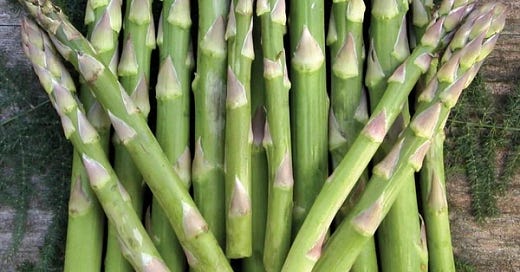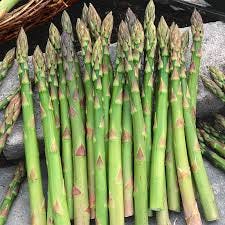ISSUE 92, POPULAR AT THE PRODUCE STAND, Part 3: Mary & Martha Washington Asparagus
Martha Washington
Mary & Martha Washington Asparagus
Some varieties of vegetable were bred into existence and prospered as market varieties because they resisted a pest or pathogen that appeared on the American landscape. The Martha Washington Asparagus became a dominant cultivar in the asparagus beds of the United States in 1919-1920 because it resisted asparagus rust, a fungus (Puccinia asparagi) introduced to New York in 1896 on a batch of imported asparagus from Europe. Rust spread rapidly through New England, then to the South and West Coasts. The worst infestation was in New York and Massachusetts.
The Massachusetts Agricultural Experiment Station allied with the Asparagus Growers Association in a project to breed a rust resistant variety at Concord. From 1906 to 1908 they gathered strains of asparagus from Europe and America. Some had moderate resistance to rust, and a cross between an American seedling cross designated A7-83 (male) and an English variety, Reading Giant (female) produced the first rust-resistant strain. IJ. B. Norton, the breeder, would name it Martha Washington. The female plants were designated Martha, the males, Washington. Selective intercrosses of these two parents were called Mary Washington. The USDA announced the availability of seed of the rust resistant asparagus in a 1919 pamphlet entitled Washington Asparagus, C. T. & F. C. D. C. Bulletin 7.
Of five strains released by Norton, two strains commanded the interest of the market: Martha Washington and Mary Washington. The latter produced well formed spears with an oval cross-section. [“Washington Asparagus Strains,” Market Growers Journal (March 1, 1922), 12]. The Mary Washington was more slender than leading market varieties such as Conover’s Colossal and Argentuiel, and thereby benefitted from an aesthetic shift that took place with the American diet craze of the 1920s (flappers were slender) that suggested to consumers that thin asparagus would produce thinner bodies in eaters.
In 1920 a “Giant Washington” strain was launched and despite adoption by major growers, such as Riverview Farms in Bridgeton, NJ, failed to gain a wide following of farmers. Within four growing seasons Mary Washington had vaulted to first place in acreage planted of Asparagus varieties and would hold this preeminence until the 1960s. Martha Washington, too, retained a portion of the market because it was a shade more rust resistant than Mary and substantially cheaper in seed or root form.





